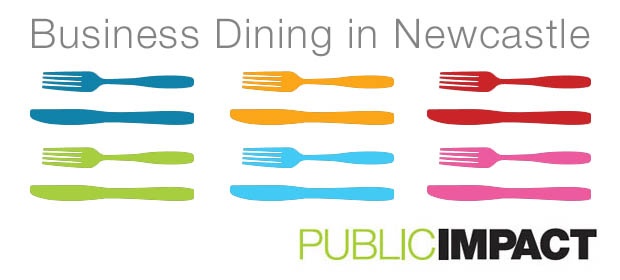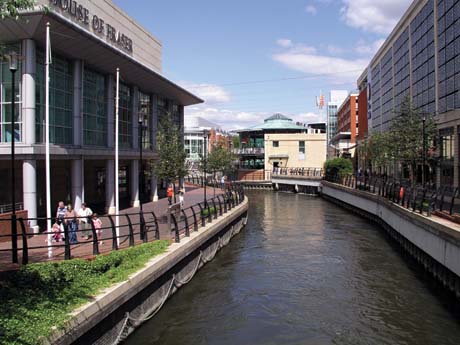Public Impact Director, John Howarth has written newspaper and magazine columns on food (among other things). He didn’t take much persuading to write this one on business dining in Newcastle upon Tyne.
One of the most noticeable changes in Newcastle in recent years is the improvement in the food offerings available through the City. In fact Newcastle has just got its first Michelin starred establishment (at least in recent years), House of Tides.
People in the North East have always liked their food and most have preferred it in substantial portions, however in the past the fare on offer has lacked some variety and maybe a bit of spice. Like the rest of the UK food has come on a bit, but over my visits in the last few years I’ve notices the change more and more. Checking out the listings magazines and online reviews there are more and more food events, farmers’ markets, specialist food stores and restaurants emphasising local ingredients not to mention the flowering of local craft breweries. From my point of view it is also great to see the continued success and development of independent (by which I mean non-chain) outlets.
Picking restaurants carefully using trusted online and offline sources we’ve been lucky to have some pretty good eating experiences. At a networking event I was attending I got into a conversation over the bacon sandwiches and my interest in food and cooking came up. The conversation turned to business lunches and which Newcastle restaurants are best for business dining?
For business dining, we want reliably good food and decent service, of course but also somewhere you can talk easily, where you’re not going to be hurried out the door and where you will feel you have had decent value for money. There is a balance when entertaining clients or thanking suppliers. The psychology isn’t about the total of the bill. The people you work for and the people you work with will get mixed messages from splashing the cash. That said, I was once taken to lunch by a supplier to whom we had channelled very significant business. I can still remember the restaurant they chanced upon with no prior knowledge. with the care-home decor and half-defrosted starters. They were very deeply embarrassed.
So:
- ALWAYS check the online reviews as well as friends’ recommendations or your personal experience. Things may have changed – the management, the chef, the suppliers. So give most credence to the most recent reviews and give most weight to longer reviews – they are written by people who care about their dining experiences.
- BUT be a little sceptical – learn to ‘discount’ the ratings somewhat. For example, Trip Advisor ratings out of five – as their scale is skewed (Terrible, Poor, Average, Very Good and Excellent). There are a lot more ‘very goods’ and ‘excellent’ than places really deserve. Also, people are much more likely to be critical of service than they are of food.
- CHECK the opening and closing times – you don’t want to be chased out but you don’t want to overstay your welcome either.
- BOOK (which may seem obvious but you would be surprised how many don’t bother) tell them it’s a business lunch/dinner and ask for a table where you can talk discretely. Your guests will appreciate the trouble you have taken more than they will having you spend your money.
- ASK your guests what they do/don’t can/can’t eat. These days restaurants that have got their act together will ask about dietary requirements, food allergies and so on – you don’t want to be calling back to find out. And BE CAUTIOUS – it’s best to play safe, at least first time out.
- BRIEF the person who actually does the booking on what you need from them – don’t expect them ‘just to know’.
So, not my ‘top five’ restaurants in the region, not my favourite food necessarily, not the best place for a romantic night out or the office party but good environments to do business and all with nearby parking:
artisan
Next door to The Biscuit Factory – a privately funded and run gallery and event venue in the much regenerated Sandyford district. Very good, modern regional food in a roomy setting. The menu emphasises the seasonal and changes regularly. There are sets for lunch and dinner which represent decent value. Good, strong flavoured game. artisan, note the lower case and the underscore, keeps it simple and does it well – and there is a lot to be said for that.
Peace & Loaf
Run by a former Masterchef Professional finalist, Dave Coulson and another excellent modern British experience that offers a great value prix fixe – £14 two courses £18 for three the last time I looked – though you can spend as much as you like in a place like this. Peace & Loaf verges on fine dining– but is more relaxed than the term suggests. If you know your guests like their food and you want to take them somewhere with adventurous but not wildly ‘out there’ dishes then this is a good choice.
21
21, formerly Café 21, is now just 21, or maybe it’s 21 Newcastle. All very confusing. There is now a Café 21 in Fenwick’s – the City’s flagship department store. So be clear where you are going. 21 is near the Quayside and is, without doubt, decent quality with a prix fixe than is good value – but be warned the a la carte is somewhat overpriced. 21 wouldn’t be my firsdt choice for a cosy night out but it’s clean modern bistro lines, crisp white table cloths and comfortably large tables make it a good comfortable business choice.
Marco Pierre White Steakhouse
Hotel Indigo, 2 Fenkle Street. NE1 5XU
Modernist and functional, Hotel Indigo is a good space for a business lunch. The Steakhouse isn’t just about steak – but the steak is very, very good. You can be reasonably cynical about a serious chef like White taking the advertising cheque for stock cubes who doesn’t exactly drop in every day but give the food a chance – it is reliable and the lunch set is locally designed rather than handed down from on high. Good, efficient service and a nice informal bar to slide into – especially if your lunch is on Friday.
A Taste of Persia
14 Marlborough Crescent. NE1 4EE
This one is my wild card. If you know your guests and you know they like something different then you could do worse than try A Taste of Persia. Persian food is about flavours rather than fire, so most palates can find something they will enjoy. The exterior is not attractive, the interior is basic but the food is very good indeed, different and very worth the visit. So be clear – this has to be sold on the food and you have to know your client is up for it, in which case you’ll be introducing them to a real treasure. There is a sister branch in a Jesmond hotel – but this is the original and rules are there to be broken.
And if this lot won’t do it for you there’s a lot more to food in Newcastle than there ever was – so we might do another of these blogs sometime soon.



